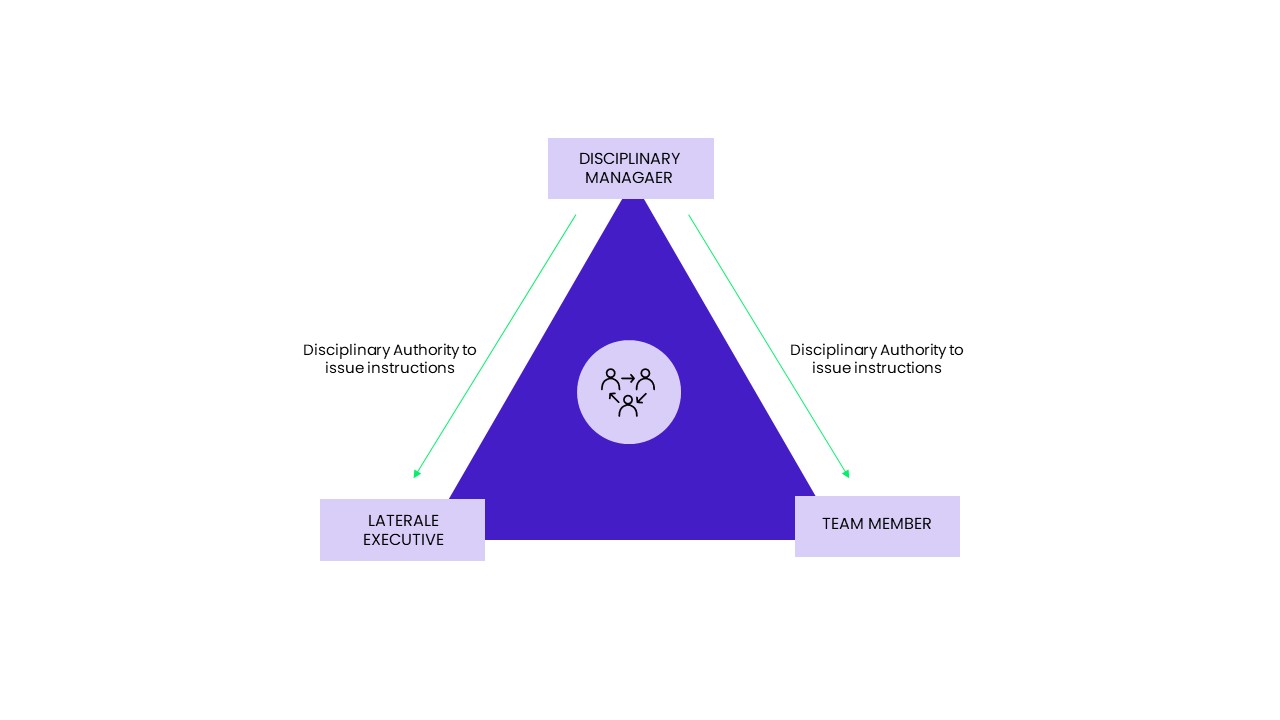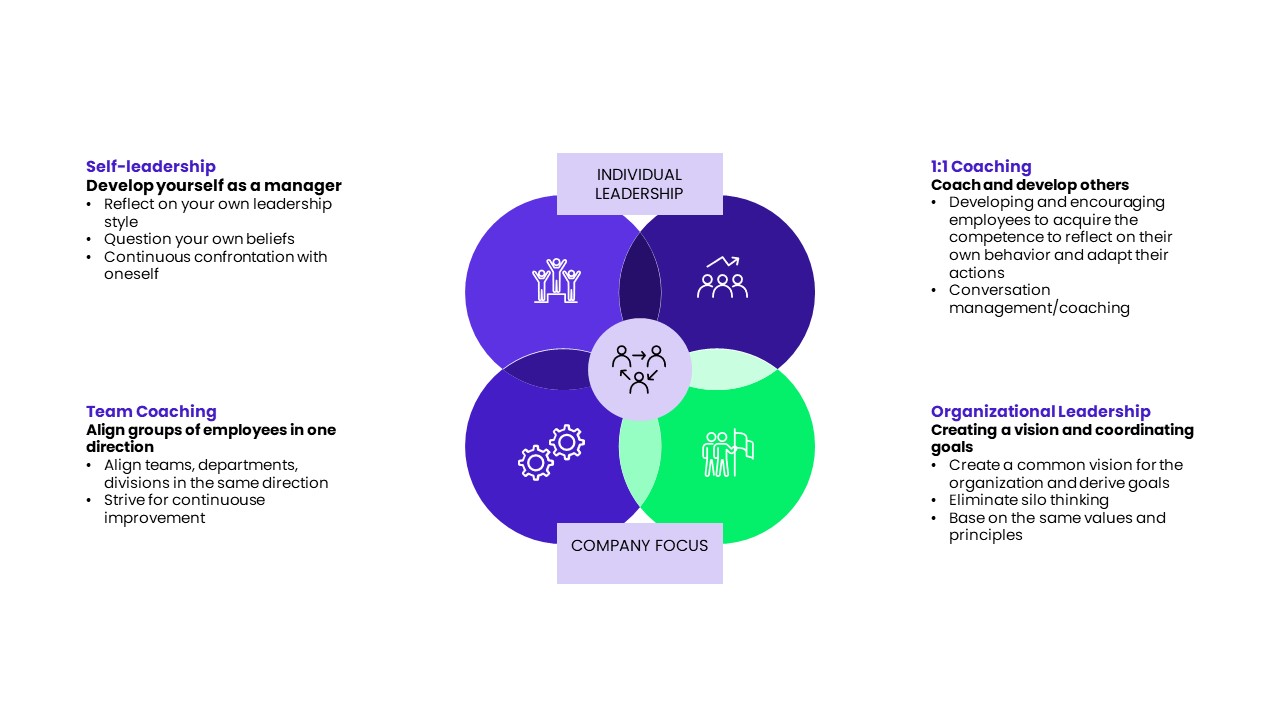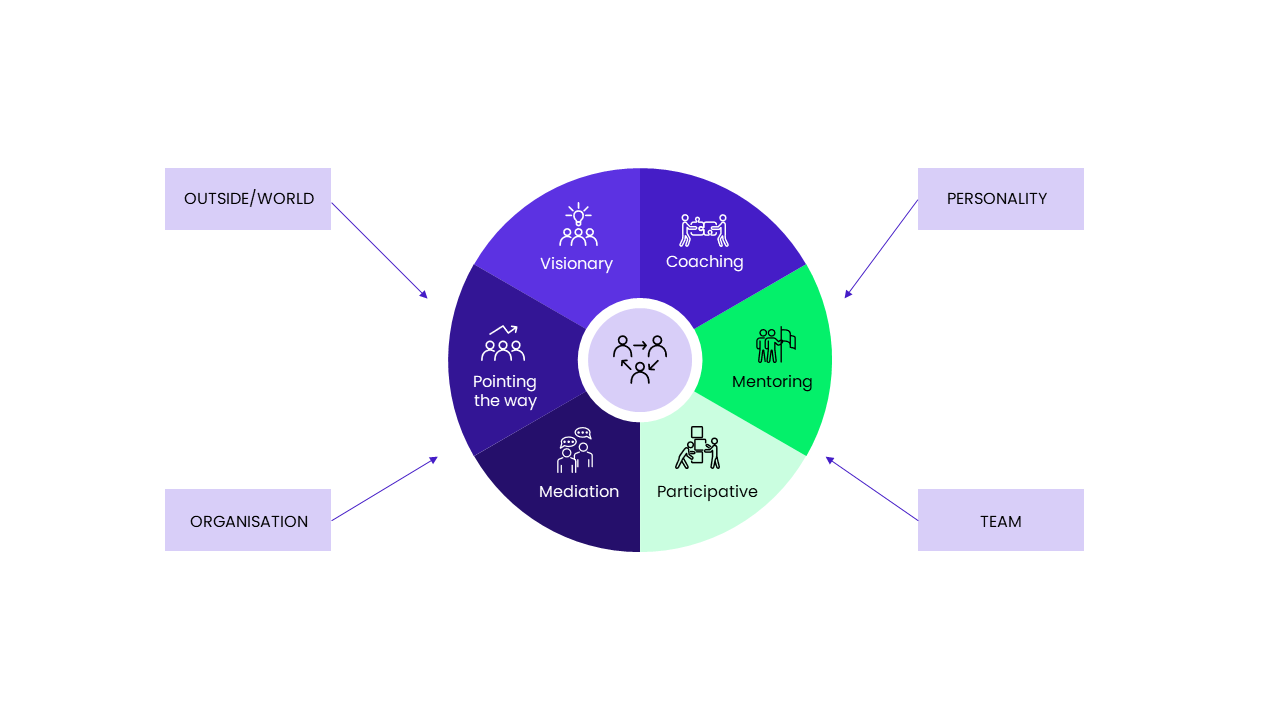Agile leadership: mastering change and making organizations fit for the future
Published May 16, 2024
- Operating Model & Agility

In today’s dynamic business world, rethinking leadership is crucial to making organizations fit for the future. Leadership skills that enable individuals, teams, and the organization to achieve greater self-organization, higher customer and employee satisfaction, and better quality results are required. “We explore the form of leadership in agile contexts and how agile leaders adapt their leadership style to different situations as required.
Agile leadership distributes leadership across many heads
When considering different forms of leadership, thoughts often turn to content-focused and disciplinary leadership tasks. In the “old” world of work, those individuals with the most pronounced technical expertise were often promoted to managerial positions at some point. As a rule, however, they not only took on content leadership (“What product are we developing?”, “What are we going to do next?”), but also disciplinary leadership. By this we mean management with the authority to issue instructions. The disciplinary manager is responsible for the development of employees and labor law issues.
This concept has a number of weaknesses. This approach places a heavy burden on managers, who must juggle a variety of responsibilities. Furthermore, it is often observed that individuals with the most specialized knowledge may not possess the necessary skills to empower employees and support their growth. These tasks require a great deal of empathy, appreciation, and inspiration.
Agile leadership learns from these challenges and distributes leadership across many individuals.
The principle that ‘agile leadership learns from these challenges and distributes leadership across many individuals’ holds particular importance for us. It shows that lessons are being learned from the identified weaknesses of the previous approach and that a reorientation is taking place. The realization that the traditional management structure is no longer fit for purpose leads to a paradigm shift. Agile leadership recognizes that a broader distribution of management tasks is necessary in order to meet the demands of the modern working world. A central element of this evolutionary leadership philosophy is the clear demarcation and simultaneous cooperation between lateral and disciplinary managers. This tight integration ensures unified direction in leadership, preventing hierarchy from being the sole determinant.
In agile organizations, lateral managers (e.g. product owners/scrum masters) without authority to issue directives are becoming increasingly important, as they are the ones who work with team members on a daily basis and lead them professionally or methodically. In addition to content management, which is the responsibility of a product owner, the role of scrum master is also becoming established. This person provides methodological leadership and ensures that the team understands and lives the agile values and principles and works well together.
In addition to lateral leadership, disciplinary leadership remains in place in most agile organizations. There is no universal solution for integrating disciplinary leadership into the agile setting. However, based on our extensive experience with agile transformations, we have identified several best practices.
A common approach in agile organizations is for disciplinary and substantive leadership to be performed by different individuals. The disciplinary leader focuses not on content but rather on leading several employees.
To ensure that both disciplinary and lateral leaders can operate successfully, close collaboration and cooperation between these two roles is crucial. A key factor for success is mutual trust. This arrangement enables an effective division of labor and lays the foundation for harmonious collaboration, allowing for optimal utilization of both leadership strengths.

The disciplinary manager has an influence on the success of lateral leadership
With the lateral and disciplinary management model, areas of responsibility also shift. For example, the disciplinary manager must relinquish responsibility for professional development, but can focus more on the long-term personal development of each individual employee. The lateral manager, on the other hand, is responsible for the outcome of a product or project and takes on tasks such as the composition of the team, communication within the team and across team boundaries and methodical leadership.
In the interaction between lateral and disciplinary leadership, it is important to clearly differentiate between the two roles from the outset. Systemic coaching can assist managers in refining their roles and developing an agile mindset.
Agile leadership: Who is actually being led?
We have now clarified which forms of agile leadership exist. However, who is actually being led in an agile setting? To answer this question, we have identified two levels with four dimensions. We examine individual leadership through the dimensions of self-leadership and 1:1 coaching, alongside organizational-focused leadership, which encompasses team coaching and leadership of the entire organization.

Agile leadership works on two levels in four dimensions
Self-leadership
A crucial prerequisite for leading others is the ability to manage oneself and the willingness to continuously develop as a leader.
This includes:
- Reflecting on your own leadership style.
- Questioning your own beliefs.
- Continuous self-reflection.
1:1 Coaching
The second dimension includes coaching and the further development of individual team members. Systemic coaching can facilitate a change in organizational culture. As coaches, managers can help employees develop skills that promote personal responsibility and initiative. These include communication, empathy and the ability to inspire employees. In general, the objectives of 1:1 coaching can be summarized as follows:
- Developing and encouraging employees to independently acquire skills for self-reflection and behavior adaptation.
- Promoting personal responsibility and initiative.
- Working out strengths and skills with individual employees and generating a vision.
Team coaching
The aim of team coaching is to align groups of employees in one direction so that they have a uniform vision and understanding of their work. Team coaching improves cooperation and enhances team performance. As in 1:1 coaching, systemic questions are used to enable the team to develop solutions independently. Parts of team coaching are:
- Encouraging the team to work in a self-organized way and to strive for continuous improvement independently.
- Defining a common way of working.
The entire organization
The organization as a whole is seen as a system made up of individual elements, like teams and individual employees, that influence each other. Changes at the organizational level or in a team have an impact on other areas of the organization. A vision for the entire organization and coordinated goals are therefore essential. Managers play a particularly important role at this level:
- Defining and delineating leadership roles.
- Identifying corporate structures and eliminating silo mentality.
- Establishing and consolidating uniform values and principles within the company.
Regardless of the role—lateral or disciplinary manager—and whether leading individuals, teams, or the entire organization, adapting one’s leadership style to the situation is essential.
Agile leaders use different leadership styles – and there is a reason for this
Agile leaders use different leadership styles because they have to decide to what extent and in what way involvement is necessary depending on the situation and the people they are leading. The following diagram shows examples of six leadership styles that are regularly used.

Different management styles are used depending on the situation
Mediation:
The role of the mediator is assumed, for example, by a Scrum Master in finding solutions in conflict discussions with team members. Here, the agile leader takes on a neutral role. All perspectives should be heard, the agile leader ensures that the team members can communicate the needs that lie behind their points of view and supports them in finding solutions without imposing them.
Pointing the way:
In agile, there is often a preconception that all ideas and initiatives come from the team. However, especially in phases of team reorganization, teams often need orientation, which the agile leader can provide. In an agile company, a directional leadership style can be practiced through Objective Key Results (OKRs). Some of the objectives are set top-down to provide direction. The teams then break down the objectives in a bottom-up, output-oriented manner. Another example is the product vision that the product owner presents to the team, with its concrete implementation resting with the team.
Visionary:
In order for teams to work in a self-organized way, agile leaders must motivate their employees with a clear and exciting vision. They also help individuals to recognize their role in this vision. The main advantage of this type of leadership is that everyone has a clear picture of the ultimate goal. Concrete examples are the project owner’s (PO’s) vision, which describes where the journey should go and shows a common thread in the backlog. The development of a team vision can be worked out using a team canvas in the retrospective.
Coaching:
Here, the manager becomes more of an observer who provides impulses but does not give instructions. Solutions are found using questioning techniques or tools that allow the coachee to reflect on themselves and recognize new scope for action. Coaching can take place both in a team and with individual team members.
Mentoring:
The agile leader becomes a sparring partner and takes on the role of an experienced advisor. In this position, mentors also act as professional and personal role models. They are experts who can provide concrete, substantive advice and support.
Participative:
The agile leader actively involves team members in decisions in order to draw full potential from all competencies. Methodologically, delegation poker or fist-of-five can be used. Delegation poker is a playful way of working out which tasks lie with the team and which are the responsibility of the manager. Fist-of-five is a voting method in which team members indicate how confident they are on a scale of 1 to 5 that something will be successfully completed.
Agile leadership as a cornerstone of transformation
A single manager for everything? This concept, always on shaky ground, should now definitely be a thing of the past. Future-proof organizations rely on the distribution of leadership responsibility among many individuals. This approach enables managers to focus on what they are particularly good at: setting strategic directions, overseeing methodologies, or concentrating on employee development. Moreover, the era of a single management style is over. Agile leaders employ a diverse toolbox of leadership styles, ensuring they meet the team’s needs at any given moment.
In successful transformations, the topic of agile leadership takes center stage. This is because leaders have great charisma. They are visible and can act as multipliers. They should therefore set a good example. If they succeed, employees will also be inspired to lead themselves more. And that, in turn, is one of the most important goals of an agile, forward-looking organization.
Wavestone supports you in your transformation and coaches your agile leaders.
So, what are you waiting for?